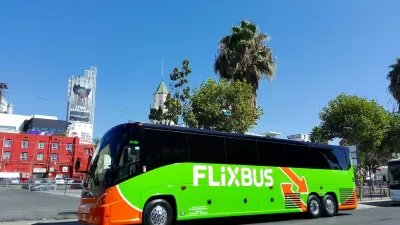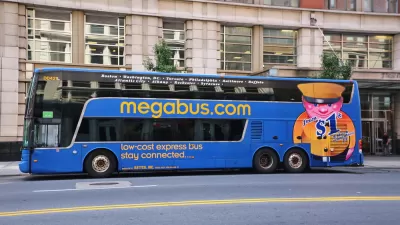Facing financial troubles, intercity bus operators are leaving passengers stranded without services in many U.S. markets.

The downward spiral for intercity bus service continues months after Coach USA, one of the nation’s biggest operators, filed for bankruptcy. Shortly after, Megabus announced it would suspend service in many of its markets, leaving passengers in a lurch.
In a piece for Streetsblog USA, Aaron Short outlines the history of modern intercity bus service and its struggle to maintain service after the pandemic, as well as its impacts on passengers who depend on it.
The disruption is the latest blow to a long-overlooked segment of the transportation sector that has failed to recover since the pandemic, been picked apart by private equity, and received little assistance from federal and state governments.
Meanwhile, bus stations with amenities are shuttering around the country as Greyhound sells off its properties, forcing bus passengers to wait for buses on poorly lit sidewalks or parking lots with no access to restrooms, shelter, or ticket agents. Few cities, such as Washington, D.C., are actively supporting intercity bus service by providing space for buses at major transit stations.
But that isn’t the case for most cities. “In some parts of the country, Megabus’s absence could prompt people to purchase vehicles or lead to less travel for job opportunities, education, and health care.”
FULL STORY: New Crisis for Inter-City Customers As Megabus Goes Bust

Study: Maui’s Plan to Convert Vacation Rentals to Long-Term Housing Could Cause Nearly $1 Billion Economic Loss
The plan would reduce visitor accommodation by 25,% resulting in 1,900 jobs lost.

North Texas Transit Leaders Tout Benefits of TOD for Growing Region
At a summit focused on transit-oriented development, policymakers discussed how North Texas’ expanded light rail system can serve as a tool for economic growth.

Why Should We Subsidize Public Transportation?
Many public transit agencies face financial stress due to rising costs, declining fare revenue, and declining subsidies. Transit advocates must provide a strong business case for increasing public transit funding.

How Community Science Connects People, Parks, and Biodiversity
Community science engages people of all backgrounds in documenting local biodiversity, strengthening connections to nature, and contributing to global efforts like the City Nature Challenge to build a more inclusive and resilient future.

Alabama: Trump Terminates Settlements for Black Communities Harmed By Raw Sewage
Trump deemed the landmark civil rights agreement “illegal DEI and environmental justice policy.”

Dear Tesla Driver: “It’s not You, It’s Him.”
Amidst a booming bumper sticker industry, one writer offers solace to those asking, “Does this car make me look fascist?”
Urban Design for Planners 1: Software Tools
This six-course series explores essential urban design concepts using open source software and equips planners with the tools they need to participate fully in the urban design process.
Planning for Universal Design
Learn the tools for implementing Universal Design in planning regulations.
City of Santa Clarita
Ascent Environmental
Institute for Housing and Urban Development Studies (IHS)
City of Grandview
Harvard GSD Executive Education
Toledo-Lucas County Plan Commissions
Salt Lake City
NYU Wagner Graduate School of Public Service





























